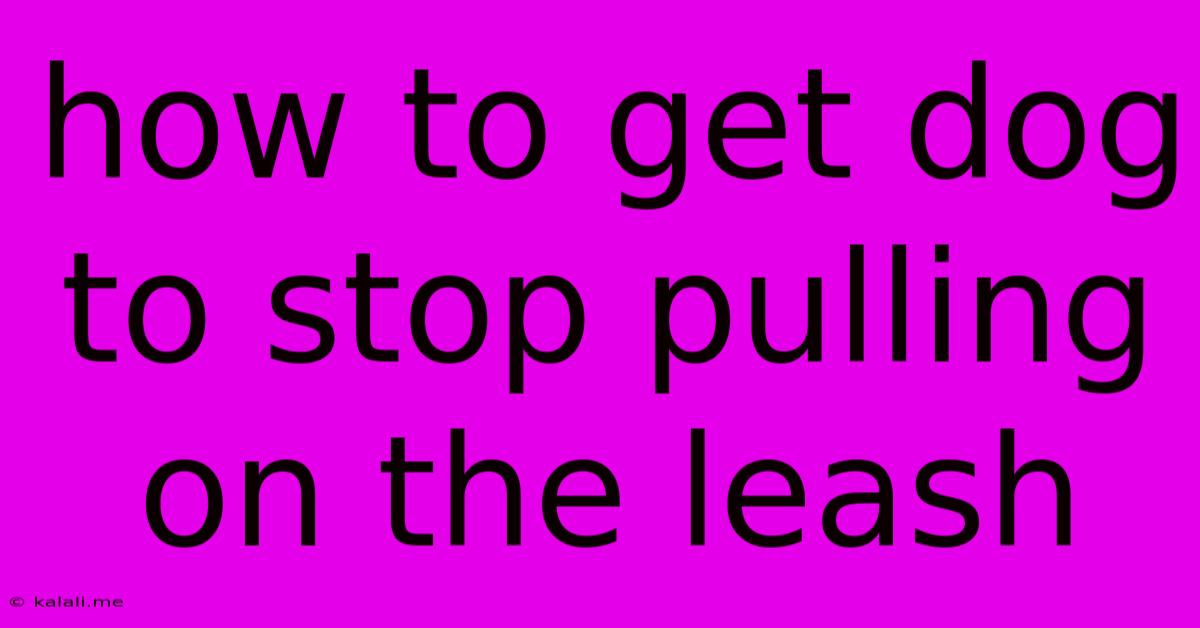How To Get Dog To Stop Pulling On The Leash
Kalali
Jun 01, 2025 · 3 min read

Table of Contents
How to Stop Your Dog From Pulling on the Leash: A Comprehensive Guide
Is your dog a leash-pulling champion? Does your daily walk feel more like a tug-of-war? You're not alone! Many dog owners struggle with this common issue, but with patience and the right techniques, you can teach your furry friend to walk politely beside you. This guide provides a comprehensive approach to leash training, covering various methods and addressing common challenges.
Why Does My Dog Pull on the Leash?
Understanding the root cause is crucial before tackling the problem. Dogs pull for several reasons:
- Excitement: The world is full of fascinating smells, sights, and sounds! Your dog's excitement can lead to pulling.
- Lack of Training: Simply put, they haven't learned alternative behaviors.
- Breed Predisposition: Some breeds are naturally more prone to pulling due to their size, strength, or hunting instincts. Think Huskies or German Shepherds.
- Strong Prey Drive: Squirrels, cats, and other animals can trigger a powerful pull.
Effective Methods to Curb Leash Pulling
Here are several proven methods to address leash pulling, ranging from simple techniques to more advanced training strategies:
1. The "Stop and Go" Method
This is a foundational technique. The moment your dog pulls, immediately stop walking. Remain completely still until the leash slackens. Once the slack appears, praise your dog and continue walking. Repeat this process consistently. It teaches your dog that pulling stops the fun.
2. The "Reward-Based" Approach
Positive reinforcement is key! Carry high-value treats (small, easily consumed). When your dog walks loosely beside you, immediately reward them with praise and a treat. This associates loose-leash walking with positive experiences.
3. Using a Front-Clip Harness
While not a training method itself, a front-clip harness can significantly aid in training. When your dog pulls, the harness gently redirects them towards you, making it less comfortable to pull. Important Note: Avoid harnesses that restrict shoulder movement.
4. The "Loose Leash Walking" Command
Teach your dog a specific command, like "loose leash," associated with the desired behavior. Pair it with the reward-based approach, rewarding your dog every time they maintain a loose leash. Consistency is vital here.
5. Seeking Professional Help
If you're struggling, don't hesitate to seek help! A certified dog trainer can provide personalized guidance and address any underlying behavioral issues. They can also help you identify and correct any unintentional mistakes you might be making.
Troubleshooting Common Challenges
- Inconsistency: The most common mistake is inconsistency. Be patient and persistent. Everyone in the household needs to use the same training techniques.
- Distractions: Start training in low-distraction areas before gradually introducing more stimulating environments.
- Dog's Strength: For very strong dogs, using a head halter or a gentle leader might be necessary, but only after mastering the other techniques.
Beyond the Basics: Maintaining Good Leash Manners
Once your dog understands loose-leash walking, continue practicing in various environments. Regular, short training sessions are more effective than infrequent, long ones. Remember to always end each session on a positive note.
By combining these strategies, understanding your dog's behavior, and committing to consistent training, you can transform your walks from a tug-of-war into a pleasant and enjoyable experience for both you and your canine companion. Remember, patience and positive reinforcement are key!
Latest Posts
Latest Posts
-
How To Get Burnt Milk Off Glass Stove
Jun 02, 2025
-
Add Height To An Existing Cinderblock Wall
Jun 02, 2025
-
Can You Get Sucked Into A Jet Engine
Jun 02, 2025
-
Still Dry Buttermilk Last Longer Than The Carton Of Buttermilk
Jun 02, 2025
-
Can I Pay Off My Sisters Rent
Jun 02, 2025
Related Post
Thank you for visiting our website which covers about How To Get Dog To Stop Pulling On The Leash . We hope the information provided has been useful to you. Feel free to contact us if you have any questions or need further assistance. See you next time and don't miss to bookmark.